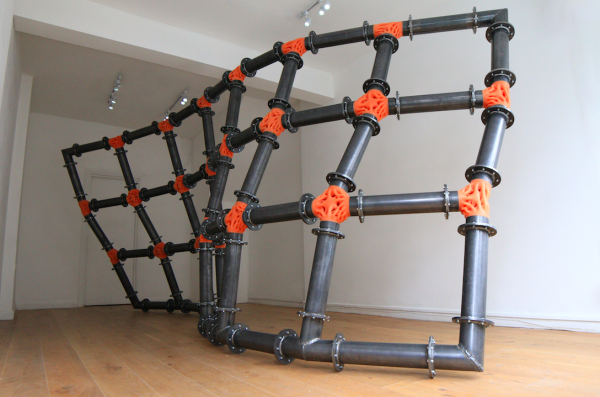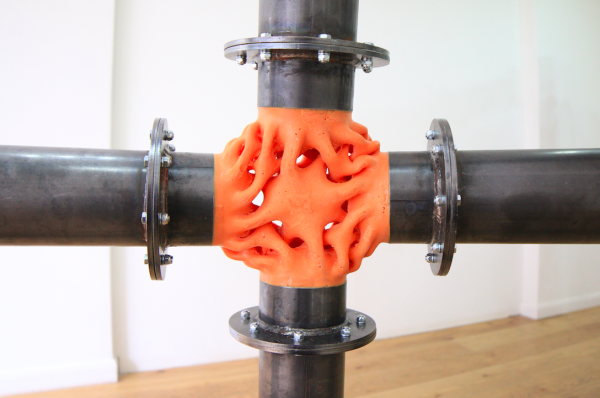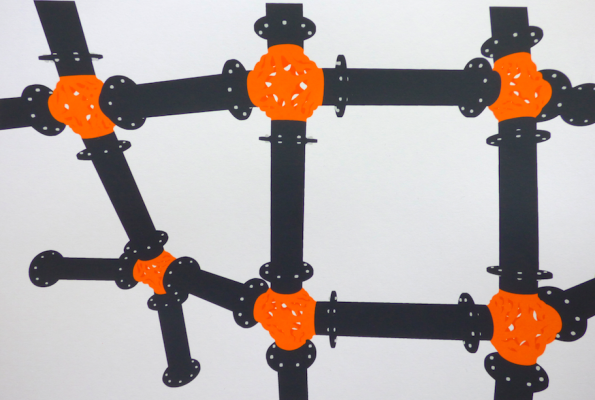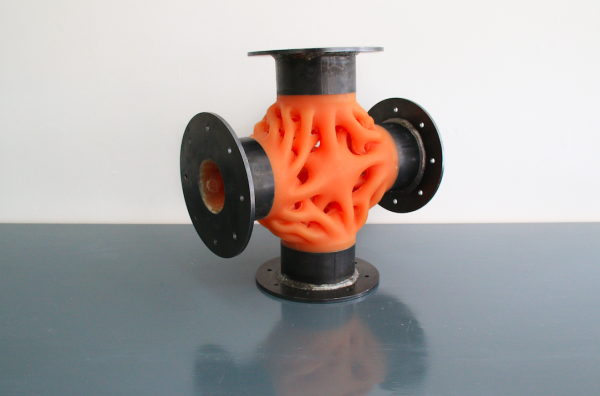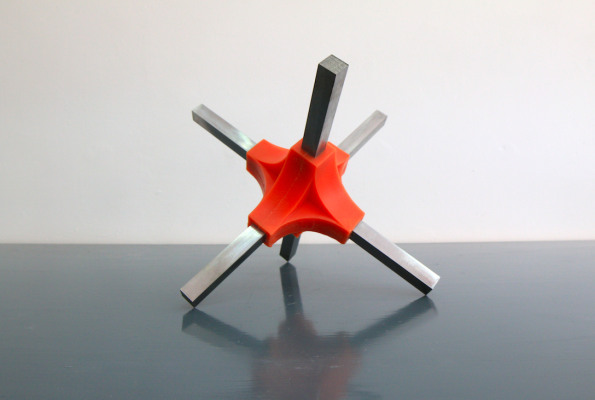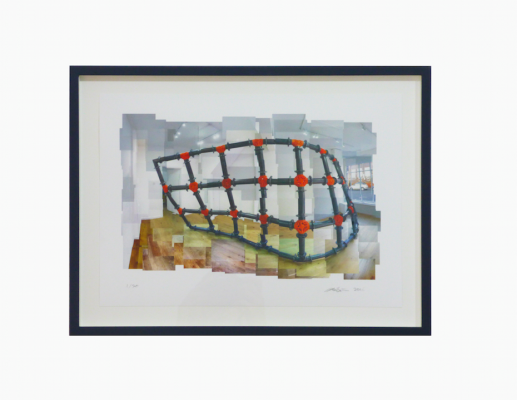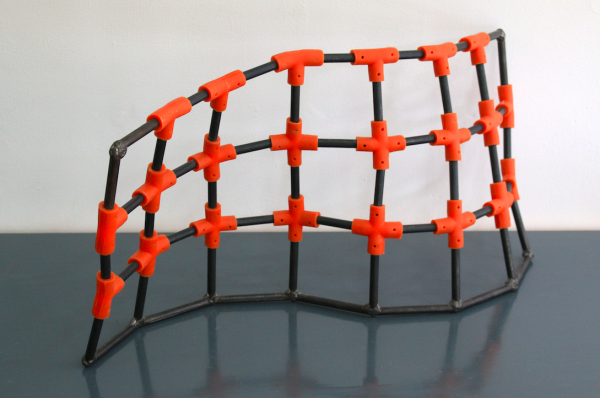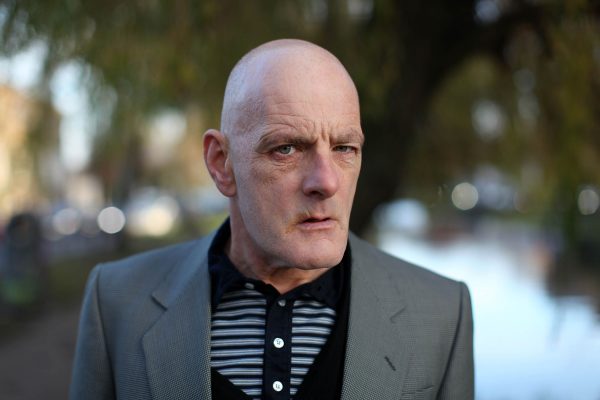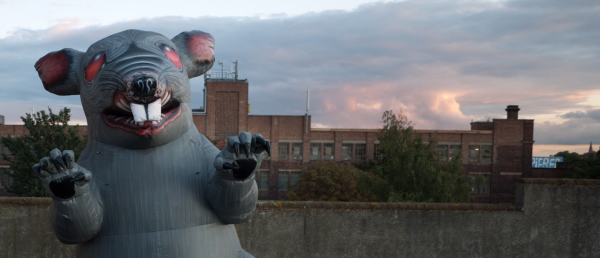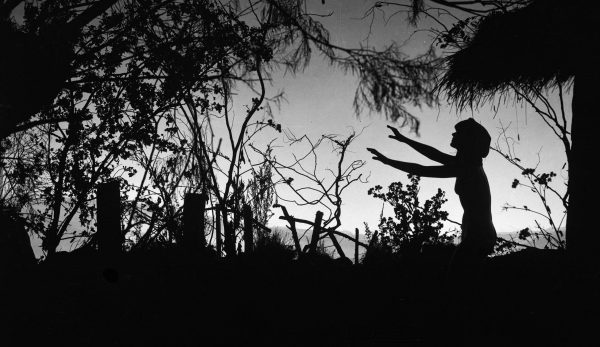Luke Hart’s Wall, recently on display at London’s William Benington Gallery, is a single, large-scale sculpture composed of a series of steel tubes held together by orange polyurethane joints. The tubes at the base of the sculpture are welded together into an elongated S-shape, such that the work curves diagonally across the gallery floor, forcing the viewer to walk around it. The welded base also provides the stability necessary for the rest of the sculpture to remain flexible. The polyurethane joints make the work to some degree elastic, determining and limiting its movements.
Wall, then, is not a wall in the conventional sense of the term. The work’s lattice or weave-like structure articulates empty space. It is a wall which, like a net, is mostly made up of holes. And while the sculpture divides the gallery, setting a porous boundary between the spectator and the world, there is little difference between what is found on one side of the wall and what is found on the other. There are further elements of the sculpture that add to its ambiguous status. The polyurethane joints, for instance, work to hold the structure together, but there is also a tactile, almost fetishistic quality to the orange rubber, which looks like a tangle of muscle sinew. This inscribes the sculpture in a bodily register and lends the work an anthropomorphic quality. Like all elastic structures, moreover, Wall quickly settles into a particular position, while also remaining in a state of potential motion. The way in which the sculpture pulls itself downwards dramatises its susceptibility to the laws of gravity. Entropy might be too strong a word for this movement, but there is an unexpected sense of precarity and instability to the work, a sense that it might teeter over under its own dead weight.
In a recent conversation, Hart explained that for him one of the most important aspects of Wall is its functionality. At first the word seemed a misnomer. It is true that, like a wall, the sculpture gets in the way, filling much of the gallery space, but otherwise its resemblance to a wall is only passing. The work looks like an enlarged maquette, or a distant cousin of one of those molecular structures made out of plastic balls and sticks that children use in chemistry classes. Functionality is also tied in to a logic of utility, and it is unclear what uses this object might have. Of course, just because a sculpture invokes the language of industry — in this respect Wall is heir to Minimalism, but also to earlier works such as the mechanical diagrams made by Francis Picabia in the early twentieth century — does not mean that that sculpture must be thought of in terms of its uses. As Donald Judd once put it, ‘design has to work, art does not.’ According to Hart, however, a distinction should be made between an object’s function and its use-value. For the artist the function of an object is more fundamental than the uses to which it is put. A function is a ‘property of a thing’, he said, while its use-value is ‘a property of our relationship to it’. The function of a building, for instance, is to stand on a horizontal and a vertical axis, while its use-value changes over time. Today a building most often becomes the object of a proprietary relation—an industrial space, for instance, is turned into a loft or a gallery—thereby reducing its potential as a thing.
In this respect, Hart’s understanding of function seems to be close to a recent development in continental philosophy known as the ‘speculative’ or ‘realist’ turn. In his book After Finitude (2008), one of the movement’s foundational texts, the philosopher Quentin Meillassoux argues against what he calls ‘correlationism’. He claims that the history of Western thought since Immanuel Kant is one in which the object exists only in its relationship to the subject. Meillassoux claims that the relegation of the material world to a realm of shadows has led to various forms of obscurantism, most notably postmodern relativism. If reality cannot be known except as a subjective projection, if it has no independent existence of its own, then it becomes impossible to make any claim to truth. Under such conditions, Meillassoux writes, ‘we only have access to the correlation between thinking and being, and never to either term considered apart from the other’. That is why he goes on to say that correlationism is ‘the contemporary opponent of any realism’. In response to this view — and it would not be possible to elaborate each stage of his argument here — Meillassoux attempts to reimagine a form of materialism which enjoys an existence independent of the subject’s relation to it, trying in this way to accede to what he calls elsewhere ‘an independent Real’.
Hart’s Wall might be seen to fulfil a comparable function. What makes the sculpture difficult to write about and to think about — and in my view this may be true of Hart’s work more broadly — is the way in which it asserts its independence from our relation to it. This is not to say that the work turns its back on the world, or that no correlation is posited between the spectator and the sculpture. On the contrary, Wall is weighed down by gravity, making it very much of this world, while its elasticity means that the work vibrates whenever someone walks near it, such that Wall enters into a reciprocal relation with its environment. A similar relationship is enacted in a miniature version of the work titled Wall: Maquette, which was also on display at William Benington Gallery, as well as a series of steel and rubber joints displayed in elegant wooden boxes, which can be picked up and manipulated by the spectator, who then becomes an extension of the work. Wall stages a similar situation. The work animates, and is animated by, the spectator. What is equally important, however, is Wall’s resistance to metaphorical or symbolic readings. The work expresses its structure and its materials and refuses to mean anything beyond itself. This impels us to think not in terms of Wall’s meaning — there is, I believe, no deeper or hidden significance to the work — but in terms of the properties of the thing — torsion, mass, elasticity, and so on — and its effects.
A common and in my view not very productive criticism of art which employs a visual lexicon derived from the language of industry is that it simply aestheticises industrial forms and renders them useless. On this view art emerges as parasitic. But this argument misses a fundamental point, one that is powerfully dramatised by Wall: namely, that the functions of art are altogether different to the uses of industry. A relation of use is often a relation between unequals, and what is interesting but also anxiety-provoking about the experience of Wall is that it takes centre stage, as it were, where it behaves as a histrionic but resolutely incompliant actor. This helps to account for the work’s affective and psychic charge. Because there is something deeply irrational and strange about Wall, an almost monstrous aspect to its elastic, muscular movements, to the way it bends and unbends into shape with violently distorting results. If Wall can be said to mark a new form of realism — not a realism concerned with representation but a realism of the object, what Meillassoux might describe as a ‘truth of the world’ — then it would seem that the primary reality of things invokes a state of flux. For the sense here is not of a stable object but of a volatile, abstract thing, one that changes and grows in vitality the longer the time spent with it; a thing, in other words, that tends towards infinity and is irreducible to the status of an object. It is as if Wall’s realist aspiration — its desire to function, its desire to be what it is and nothing else — were always on the brink of turning itself inside out, so to speak, in the fulfilment of its own logic.
